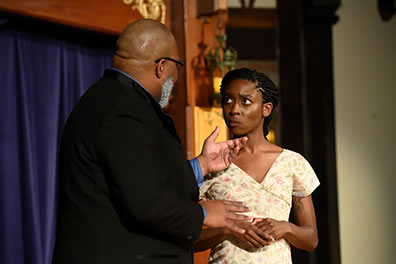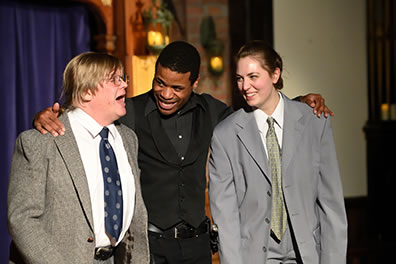Hamlet
Deacon Blues
Baltimore Shakespeare Factory, St. Mary's Community Center, Baltimore, Maryland
Sunday, April 14, 2019, third pew of old church
Directed by Chris Cotterman

Hamlet (Terrance Fleming, in black) and Laertes (Joshua Street) duel as Claudius (Terry O'Hara, left) and Osric (Madeleine Adle Koon) watch in the Baltimore Shakespeare Factory's Original Pronunciation production of William Shakespeare's Hamlet at St. Mary's Community Center. Photo by Will Kirk, Baltimore Shakespeare Factory.
The Baltimore Shakespeare Factory uses an old church for its theater, now St. Mary's Community Center. Shortly before the company's Original Pronunciation (OP) production of William Shakespeare's Hamlet this Sunday afternoon, I head to the restroom. In the hallway I encounter an elderly black man with neatly trimmed gray beard running the temple-to-temple length of his jaw and wearing a black suit with royal blue shirt and matching striped tie. He looks and bears himself like an AME Church deacon, nodding to me with curt courtesy. Having seen a couple of black women in Sunday church attire in the vestibule moments before, I figured a church council meeting was finishing up downstairs.
The ladies may have been here for a meeting, but this man is here for the play. He is Polonius. The bigger shock is seeing the actor, Shaquille Stewart, during the after-show talkback. Beard removed and suit exchanged for a vest revealing bulging arms, Stewart now looks and bears himself like a young character in a John Singleton film. Meeting Stewart later, I learn that Baltimore Shakespeare Factory Founding Artistic Director Tom Delise has tapped him to assistant direct an upcoming production this summer and direct next season's Much Ado About Nothing.
The contextual significance of this encounter began almost exactly a year ago with the stellar Delise-helmed OP production of Othello. Baltimore Shakespeare Factory stages one OP production per year, and longtime company member Chris Cotterman was slated to direct this year's OP Hamlet (this fifth production makes Baltimore Shakespeare Factory the leading producer of OP Shakespeare in the world). In a conversation with Cotterman, I broached the potential of casting last year's Othello, Troy Jennings, as Hamlet. I had race in mind, believing that a black Hamlet would be culturally and commercially significant for the Baltimore Shakespeare Factory, but I also opined that Jenkins with his acting chops and OP skills might make the best Hamlet, black or white. Cotterman replied that he didn't want race to factor in any casting decision, one way or another. A noble sentiment, one that, in its substance, I endorse. However, race-blind aspirations are difficult to put into practice; human culture being what human culture is, we always slide to our comfort zones. That's one reason whites hate discussing matters of race: it's too uncomfortable to acknowledge our predilection to fall back to the culture we know than embrace one we don't fully understand.
We're in Baltimore, so let's talk race. The "Charm City" charmed me when I first started visiting here 30 years ago and was among our finalists as a permanent landing spot when my wife, Sarah, completed her Air Force career. However, Baltimore has been enduring the slings and arrows of outrageous misfortune, taking up arms against its sea of troubles as centuries-long fissures between whites and people of color erupted four years ago with the uprising that followed Freddie Gray's death in police custody. I figured showcasing Jennings as an OP Hamlet would have huge significance for company and community.
I was kind of right; I just underestimated the acting talent in Baltimore and forgot how much I should trust Cotterman. This production showcases many solid practitioners of OP, including a black Hamlet (Terrance Fleming), a black Laertes (Joshua Street), a black Ophelia and Fortinbras (Rachel Manu), a black Cornelius/Player 4/Fortinbras' Captain/Pirate (intern Dylan McKenzie), and a black Polonius. I don't know if Cotterman considered race in his casting choices, but the performances are evidence that talent and Shakespearean understanding were foremost in his mind. The result is profound. What Cotterman achieves is not merely a black Hamlet nor merely an OP Hamlet but a Baltimore Hamlet, a company of actors displaying cohesive, multiracial artistry and energy while performing a standard of Shakespeare singular to this city. Oh, and this production is one of the company's biggest commercial hits, too.
Costume Designer Kendra Shapanus fashions the characters in modern dress. The guards wear circa 1980s camouflage pants; Horatio (Ethan Larsen) a pinstripe vest; Laertes a gray vest, blue jeans, and brown riding boots; Ophelia a simple flower-print dress; Gertrude (Melanie Bishop) a sparkling blue cocktail dress and short black satin jacket; and Claudius (Terry O'Hara) a navy pinstripe suit, light blue shirt, silver tie, blue sash, gray cape, and a jewelled band around his head for a crown. Instead of Hamlet entering with the rest of the court at the start of the play's second scene per the text, his arrival comes when Claudius first addresses his nephew: "Now, my cousin Hamlet, and my son," O'Hara says to Fleming strolling down the church aisle wearing a black dinner jacket, black vest, black shirt, black jeans with a Bayside patch at the top of the right thigh, and black knee-high riding boots. "A little more than kin, and less than kind," Fleming's Hamlet says snarkily to a person in the audience. Fleming immediately establishes two qualities: he's quite the physical specimen, and he's a smart-ass Hamlet.
Fleming foregoes moroseness to portray Hamlet as frustrated by his state. He's grieving for the death of his father, but more on display is his anger in the way Claudius maneuvered—including marrying Hamlet's mother, the widowed Queen Gertrude—to intervene in gaining the crown. Hamlet just wants to go back to school at Wittenberg and get away from Elsinore, but Cotterman's blocking makes clear that the desire for his remaining is not the king's but Gertrude's. Claudius, in a show of subservience to Gertrude, even kneels to Hamlet, pleading their case. Agitation, not depression, prompts Fleming's launch into Hamlet's first soliloquy, "O, that this too too solid flesh would melt, thaw, and resolve itself into a dew!"
Fleming's most revealing moment, best illustrating his approach to Hamlet's character arc, is in the soliloquy "O, what a rogue and peasant slave am I!" Every Hamlet I recall says these lines as self-flagellation, as this speech comes after The Player (Erin Hanratty) has shed tears speaking of Hecuba ("What's Hecuba to her or she to Hecuba?" Hamlet says). Fleming, though, points this soliloquy to Hamlet having just laid the groundwork for the mousetrap. "O, what a rogue and peasant slave am I" comes with a gleam in his eye and self-congratulation in his tone, more Richard III in delivery than Richard II. Fleming fleshes out Hamlet's passion for Ophelia with raw, emotional outbursts in the nunnery and graveyard scenes, but otherwise, his Hamlet is fundamentally irreverent and always scheming. Hamlet's letter to the king (delivered by the pirate) always seemed to me a superfluous composition, but Fleming's Hamlet would write such a snippy letter.
In an interesting piece of stage business, when the king drinks to Hamlet, Fleming looks away. Yet, he doesn't suspect a conspiracy in his duel with Laertes, even though Claudius set it up; Hamlet blindly trusts Laertes. Fight Director Tegan Williams capitalizes on the physicality that Fleming and Street bring to their portrayals of Hamlet and Laertes, and the bout ends with an exquisite feint and thrust by Hamlet. The scene's coup de grace, though, is the poisoned queen falling just as Laertes is stabbed. They hit the floor at almost exactly the same time.


The two sides of Ophelia (Rachel Manu): top, obeying her father, Polonius (Shaquille Stewart); above, demonstrating disdainful pride in her mad scenes as her brother, Laertes (Joshua Street) watches. Photos by Will Kirk, Baltimore Shakespeare Factory.
Though Fleming is a standout Hamlet, his is not the production's blow-away performance. That comes from a newcomer to Shakespeare (let alone OP), Manu as Ophelia. She presents a perfect balance of a proud but naïve young woman in the play's first half, but rather than the character's naïveté informing her performance in the second half, Manu pushes Ophelia's innate pride to the forefront of her mad scenes. It's as if her mental breakdown unleashes her true nature. She's a commanding presence in the room (per the words in her lines). She holds her hand up for Horatio to kiss, and when he tries to ignore her, she punches his mouth. She sings her songs directly to the audience, and on the line "Young men will do't, if they come to't; by cock, they are to blame," she winks at an audience member. This is a potent Ophelia, and taken together with her all-business, politically astute portrayal of Fortinbras, Manu establishes herself as a nascent Shakespearean talent.
This Hamlet exhibits the merits of Baltimore Shakespeare Factory presenting at least one Shakespeare play per year in the dialect of Shakespeare's time. Ann Turiano is the OP director for the second consecutive season, and what she got the Othello cast to accomplish last year she builds upon with this cast. The OP delivery does not put up much of an impediment to modern audiences understanding the dialogue, and Cotterman even has his actors use OP in preshow announcements and raffle-ticket sales between performances of mandolin-accompanied 16th century music. One of the characteristics of OP is how characters are defined not only by what they say but how they sound. Take this passage by Claudius: "My stronger guilt defeats my strong intent; and, like a man to double business bound, I stand in pause where I shall first begin, and both neglect." The compounding consonants in OP make O'Hara speak with guttural vulgarity, even though he's contemplating his desire to pray. Another revelation comes with the dropping of the H sound in OP. That makes Hamlet "Amlet" (the source character's name is Amleth), and Horatio becomes "Oratio."
The real aural challenge of this production is not OP but the space's acoustics. This is an old church, after all, and churches are notorious for their bad acoustic architecture. Cotterman's blocking puts many interactions at the back of the stage, which suits the the theater's deep-thrust configuration with audiences on either side of the stage. For me in a third-row pew in front of the stage, however, the lines of actors in the back half of the stage hit an invisible curtain of audibility (excepting O'Hara as Claudius and Manu as Ophelia and Fortinbras, both actors displaying proper projection skills).
I've long appreciated Cotterman's intelligence as a Shakespearean actor and director, and he demonstrates his acumen in this production, too. Given the company's dedication to original staging practices (no sets, no electronic or digital effects, universal lighting, and textual fealty), his are subtle touches.
- After their first encounter with the ghost, Marcellus (Conrad Deitrick) asks Horatio, "Is it not like the king?" "As thou art to thyself" Horatio replies and hands Marcellus a wad of cash, obviously paying off a bet.
- Upon his departure, Laertes clasps his dad in a hug (it echoes through the church), runs to Ophelia and twirls her in their embrace, and then jumps off the stage and runs up the center aisle. When he next appears, Laertes rushes down the aisle with roaring intent to kill, all that love-borne energy of his exit now turned to hate-fueled aggression. Taken together, these visuals serve as an emotional barometer for the tragic consequences for people beyond the principal players of violent political discord.
- The Ghost (hooded and wearing a white mask, uncredited in the cast list) makes his second exit by jumping down into the trapdoor. Whoa.
- Reynaldo (Hanratty) writes down in a notebook Polonius's instructions for spying on Laertes in Paris.
-
Rosencrantz (Sean Eustis) takes a buddy-buddy approach with the king while Guildenstern (Madeleine Adele Koon) bows, displaying proper courtesy. These behaviors (with subsequent reactions by king and queen) get their cues in the lines. Playwright Tom Stoppard understood that Rosencrantz and Guildenstern are not Tweedle Dee and Dum, but only recently have I seen directors grasping that Shakespeare wrote two distinct personalities. This production takes that notion a notable step further. After the mousetrap, when Hamlet is calling out his two old buds, he says "You would play upon me" to Rosencrantz, and "You would seem to know my stops" to Guildenstern. Hamlet's specifically directed accusations perfectly sum up the different approaches Rosencrantz and Guildenstern have taken toward him.

Hamlet (Terrance Fleming, center), greets Rosencrantz (Sean Eustis, left) and Guildenstern (Madeleine Adele Koon) in the Baltimore Shakespeare Factory's Original Pronunciation production of William Shakespeare's Hamlet. Photo by Will Kirk, Baltimore Shakespeare Factory.
- Hamlet is scribbling in a notebook as he enters to speak his "To be" soliloquy. Upon seeing Ophelia, he hands the notebook to a member of the audience. At scene's end, with one last order for Opehlia "to a nunnery, go," he angrily snatches the notebook away from the patron and stalks out.
- "Can you play the Murder of Gonzago?" Hamlet asks the Player. "Ay, my lord," the Player responds, but Hanratty's expression is "Let's not."
- McKenzie's eyepatch-wearing Pirate has a hook for a hand, with Hamlet's letter to Horatio stuck on its point. Horatio pulls off the letter, and as he reads it, McKenzie begins scratching herself with her hook. Horatio glances up and she embarrassedly hides her hook behind her back.
Along with this bit of slapstick, the Pirate scene includes a significant textual insertion. As Horatio and Marcellus discuss the letter, Gertrude arrives and Horatio shares the letter with her. Gertrude is now fully aware of the king's villainy and is joined with Hamlet and Horatio in their actions. This scene comes from the First Quarto, the "Bad Quarto" generally dismissed as a corrupted version of the play. This plot track is missing from the Second Quarto and First Folio versions of the play, significantly altering Gertrude's character arc. Cotterman merged the three editions of the play for this production but cut 1,200 lines to bring it in at 2:30, including a 15-minute intermission.
About that intermission, Deacon Polonius appears on the balcony, announces, "It's intermission," and begins to preach: "Dearly beloved, we have gathered here today to get through this thing called life." This is the opening lines to Prince's Let's Go Crazy, and the curtain to the back stage opens and the cast emerges to perform the full song plus three others from Prince's Purple Rain album: the title track, When Doves Cry, and I Would Die 4 U (all fitting numbers for Hamlet). Street fronts the group, displaying electric vocal and movement chops—quite the counterpoint to the Renaissance music and OP announcements of the preshow. Electric is the band, too; literally. Using amplified electric guitar and bass is a major departure from the company's original staging principles, as is a single lighting cue in which Cotterman darkens the theater for the Murder of Gonzago (candelabras are brought on stage). I love the Prince set (though Delise indicated it might be the last time his company plugs in), but the light dimming is cumbersome and unnecessary.
Original staging practices (for the most part), original pronunciation—yet this production is very 21st century Baltimore because of what this cast brings to this familiar story. It might not even be intentional, just a juxtaposition of the actors' cultural experiences and the audience's expectations. This is what makes Stewart's portrayal of Polonius so poignant in the context of Baltimore, a city that became a flashpoint of the Black Live's Matters movement with the Freddie Gray uprising. For many upwardly mobile African-Americans, some of whom, like Deacon Polonius, are pillars of the community, navigating the movement is fraught with consequences from all angles. This production makes no overt reference to Black Lives Matter, but by playing his character as an archetypal figure of the African-American community, Stewart brings home Polonius's tragedy all the more powerfully. Deacon Polonius is a righteous man devoted to his family's continuing prosperity while pursuing his sense of civic duty. You might see Polonius as a complicit victim, you might see Polonius as an innocent victim. Stewart portrays Polonius as many such best-intentioned people, an unfortunate victim of entrenched political and social forces that mask blind rage as justice.
Eric Minton
May 7, 2019
Comment: e-mail editorial@shakespeareances.com
Start a discussion in the Bardroom



 Find additional Shakespeareances
Find additional Shakespeareances